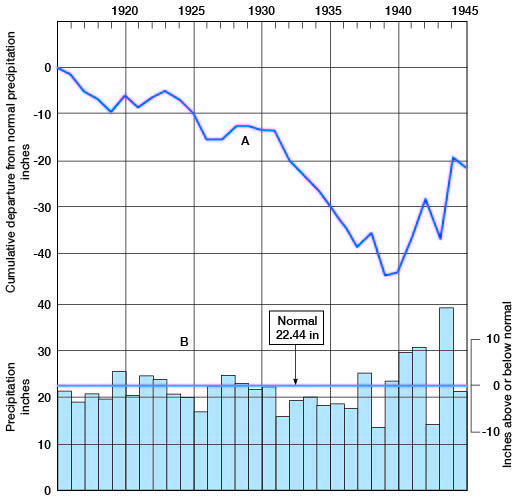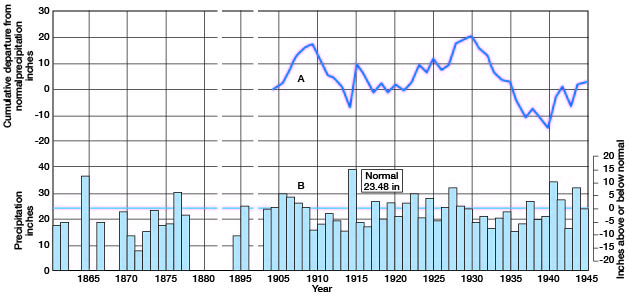Prev Page--Introduction || Next Page--Geology
Geography
Topography and Drainage
Pawnee and Edwards counties are in the High Plains section of the Great Plains physiographic province. For the purpose of detailed description, Pawnee and Edwards counties may be divided into three areas based on topography: (1) upland area, (2) valley area, and (3) dune-sand area.
Upland area--This area includes most of Pawnee County lying north of the Pawnee Valley and parts of Pawnee and Edwards counties lying between Pawnee Valley and Arkansas Valley. The area consists primarily of low rounded hills, which are separated by the many valleys that have been carved by the tributaries of Pawnee and Arkansas Rivers. The maximum relief in this area generally is less than 100 feet and in a few places in northwestern Edwards County the land is relatively flat. The maximum altitude in the area is about 2,300 feet at the Ford-Edwards county line north of Offerle.
Valley area--The valley area consists primarily of the valleys of Pawnee and Arkansas Rivers. The area contains flat, relatively featureless bottomlands and terraces. The Arkansas Valley slopes from an altitude of about 2,260 feet at the Ford-Edwards county line to about 1,920 feet at the Pawnee-Barton county line. The average gradient of Arkansas River is about 7 feet per mile. The Pawnee Valley enters Pawnee County near Burdett and converges with the Arkansas Valley near Larned. It consists of a relatively flat alluvial plain transected by many abandoned channels of Pawnee River. Adjacent to the bottomland is a broad flat terrace, which generally extends about a mile on each side of the bottomland. The Pawnee Valley slopes from an altitude of about 2,080 feet at the Pawnee-Hodgeman county line to about 1,990 feet at its confluence with the Arkansas Valley. The average gradient of Pawnee River is about 2 feet per mile.
Dune-sand area--The dune-sand area consists of the part of Pawnee and Edwards counties lying south of the Arkansas Valley. The topography ranges from relatively flat areas to irregular areas containing high sand hills. Most of the sand hills are adjacent to Arkansas River and they contain many undrained basins (Pl. 4). The areas of more moderate relief are flat to hummocky and are in part drained by streams such as Hubbard Creek, Wild Horse Creek, and Rattlesnake Creek.
Plate 4--Water-filled depressions in the dune sand area. A and B, North of Trousdale at the corner of secs. 20, 21, 28, and 29, T. 25 S, R. 16 W., Edwards County. C, Along a small intermittent stream about 1 mile northwest of Ray, Pawnee County.

Climate
The climate in Pawnee and Edwards counties is similar to that in other parts of the High Plains section. The area has relatively low precipitation, rapid evaporation, and a wide range of temperatures. The summer days generally are hot, but the summer nights are relatively cool, owing to the movement of wind and to the relatively low humidity.
The precipitation in Pawnee and Edwards counties is sporadic; hence the amount of rainfall in one storm may differ greatly from one part of the area to another. The greatest annual precipitation recorded in this area was 39.63 inches at Larned in 1915. (All climatic data, unless otherwise stated, are based on records of the U.S. Weather Bureau stations at Larned and Trousdale.) The second greatest precipitation was 39.11 inches at Trousdale in 1944. The least precipitation recorded was 7.97 inches at Larned in 1872. The normal annual precipitation at Larned is 23.48 inches (Fig. 2) and at Trousdale it is 22.44 inches (Fig. 3). The greatest precipitation in the Pawnee-Edwards area occurs during late spring and summer and the least during the winter.
Fig. 2--Graphs showing (A) the cumulative departure from normal precipitation at Larned and (B) the annual precipitation at Larned. A larger version of this figure is available.
Fig. 3--Graphs showing (A) the cumulative departure from normal precipitation at Trousdale and (B) the annual precipitation at Trousdale.

Mineral Resources
The principal mineral resources of Pawnee and Edwards counties are oil and gas. The oil and gas pools in this area in 1945 included the Belpre oil and gas pool in Edwards County and the Pawnee Rock, Benson, and Ryan oil pools, the Shady gas pool, and the Zook oil and gas pool in Pawnee County. A successful wildcat well was completed in Pawnee County late in 1945 opening the Ryan Southeast pool. The reader is referred to Ver Wiebe (1947) for a more detailed discussion of oil and gas in this area.
Other mineral resources in Pawnee and Edwards counties include sand, gravel, and building stone. Sand and gravel has been taken from the alluvium of Arkansas River in both Pawnee and Edwards counties. It is used primarily as road metal.
Building stone has been quarried from the Greenhorn limestone in the northern part of Pawnee County. The stone generally is quarried from the "Fencepost" limestone bed at the top of the Greenhorn limestone although other beds of limestone in the Greenhorn have been quarried in a few places. The stone is used in the construction of buildings and as fence posts.
Agriculture
There were 644,820 acres of land under cultivation in Pawnee and Edwards counties in 1945. (All agricultural data are from reports of the Kansas State Board of Agriculture.) The principal crop in the area is wheat, which is grown primarily on the upland areas north of Pawnee River and between Pawnee and Arkansas Rivers. In 1944 there was 8,704 acres of land under irrigation in the Pawnee-Edwards area, principally in the Pawnee and Arkansas Valleys. The principal irrigated crops grown in this area were alfalfa, sorghums, and sugar beets. The list of crops grown in Pawnee and Edwards counties given in Table 1 was compiled for the 1945 census.
Table 1--Acreage of principal crops grown in Pawnee and Edwards Counties in 1945
| Wheat | 529,391 |
| Sorghums | 69,826 |
| Corn | 4,066 |
| Barley | 19,221 |
| Alfalfa | 9,327 |
| Hay (other than alfalfa) | 505 |
| Rye | 3,898 |
| Oats | 8,293 |
| Sugar beets | 239 |
| Miscellaneous crops | 54 |
| Total | 644,820 |
Population
The population of Pawnee and Edwards counties increased from 16,380 in 1920 to 17,805 in 1930. The extended drought during the next decade resulted in a decrease of 6.3 percent in the population. In 1945 the population of Pawnee County was 8,255 and of Edwards County was 5,787. Larned, the county seat and Principal City of Pawnee County, had a population of 3,595 in 1945, and Kinsley, the county seat of Edwards County, had a population of 2,112. Other cities in these counties include Lewis (population 397), Garfield (population 308), Belpre (population 229), Offerle (population 221), and Rozel (population 204).
Transportation
The main line of the Atchison, Topeka, and Santa Fe Railway crosses Edwards County and serves the communities of Belpre, Lewis, Kinsley, and Offerle. A branch line of the same railroad crosses Pawnee County along Arkansas River and joins the main line at Kinsley. This line serves the communities of Larned and Garfield. The Atchison, Topeka, and Santa Fe Railway Company also has a spur line that extends from Larned to Jetmore in Hodgeman County. The communities in Pawnee County served by it are Frizell, Sanford, Rozel, and Burdett. A branch line of the Missouri Pacific Railway serves the community of Ray and terminates at Larned.
The principal highways in Pawnee and Edwards counties are U. S. Highways 50 North and 50 South and Kansas Highway 45. U. S. Highway 50 North crosses Pawnee County and serves Larned, Rozel, and Burdett. U. S. Highway 50 South crosses Edwards County and serves Belpre, Lewis, Kinsley, and Offerle. Kansas Highway 45 enters Edwards County near Offerle and extends along Arkansas River from Kinsley to Great Bend in Barton County. Other highways in this area include U. S. Highway 183 and Kansas Highway 1, which cross the area from north to south, and Kansas Highway 19, which extends from Belpre to near Larned and then eastward into Stafford County.
Pawnee and Edwards counties have excellent county highways in addition to the many State and Federal highways. Many of the county roads in this area are all-weather hard-surfaced roads, whereas others have been surfaced with sand and gravel.
Prev Page--Introduction || Next Page--Geology
Kansas Geological Survey, Pawnee and Edwards Geology and Groundwater
Comments to webadmin@kgs.ku.edu
Web version June 2004. Original publication date March 1949.
URL=http://www.kgs.ku.edu/General/Geology/Pawnee/04_geog.html
